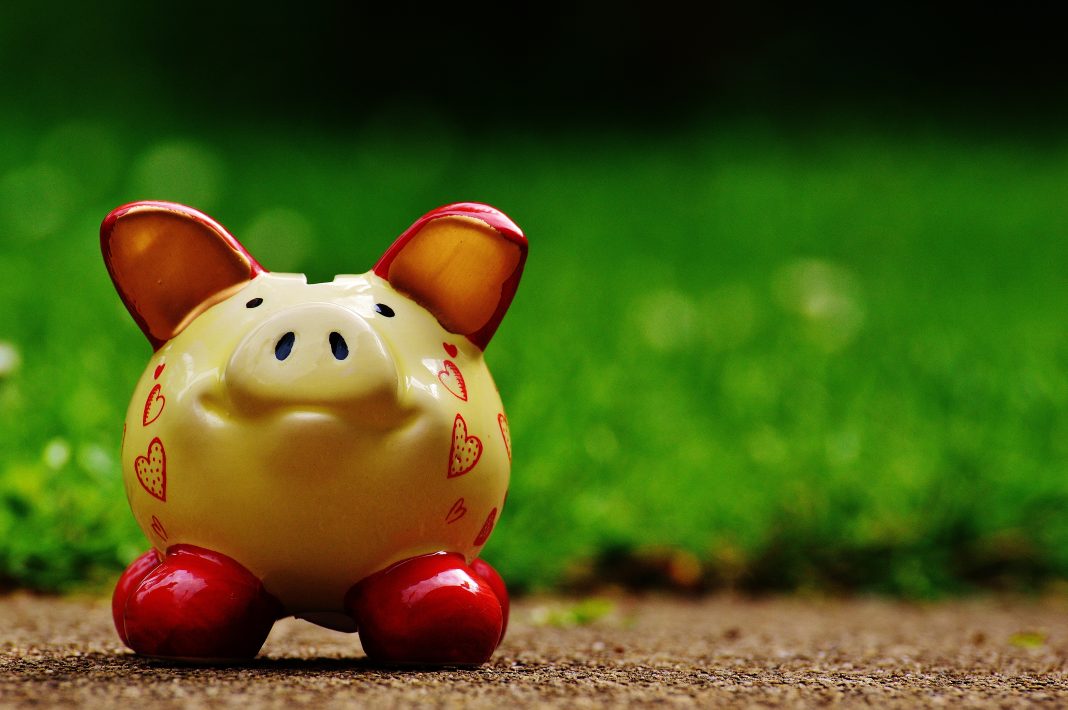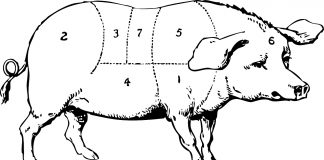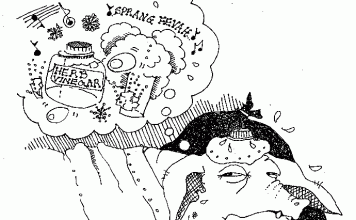| Issue #107 • September/October, 2007 |
My friend Jeanie, a professional woman, whips out her credit card at every spending opportunity. Wal-Mart expedition? Credit card. A week’s worth of groceries? Credit card. DVD rental? Yep, you got itout comes the credit card. If gumball machines took credit cards I wouldn’t be surprised to see Jeanie pop a ten-cent purchase onto that card.
It’s the new American way andso the propaganda of the cashless society tells usthe way of the future.
Ick!
Now don’t get me wrong. Jeanie uses her credit card responsibly. She and her husband pay the bill in full every month. The card mostly gives them a convenient, easily trackable record of spending (“Honey, did you pay $159 for a new gas-powered weed-whacker last month? I sure didn’t.”).
We all know it; a credit card can be a blessing when the car breaks down or you finally stumble upon those bargain-rate solar panels you’ve been looking forjust when your cash is tapped out. Credit cards offer purchase protection; if you get “had”, they give you recourse. Some things, like renting a car or buying gas at certain service stations, you can’t do at all unless you have a credit card.
But we all know, too, the perils of constant creditlike impulse buys and being seduced by credit offers whose fine print is as insidious as a politician’s promise. Miss making that full payoff just once and you can plunge into the Darkest Depths of Credit-Card Hellchained to usurious finance charges and late fees high enough to pay Christmas bonuses for the credit-card vendor’s executive staff. Amazing how easy it is to stumble into that hell and how hard it is to struggle, bite, and claw your way out.
When we get into debt, somebody elseusually some corporate strangerliterally owns a portion of our future life. Talk about ick!

Then, too, an increasing lot of us are realizing that having trackable purchases is more “convenient” for various snoops and profilers than it is for us.
So. That leaves some, including yours truly, paying for every possible thing with grubby, old-fashioned pieces of paper. I suspect a fair number of BHM readers are with me on this.
We might be behind the times, but we’re telling snoops to mind their own business and are avoiding selling our future for a mess of DVDs or a pair of boots we’ll never wear. We tell ourselves we can regularly set cash aside, in a savings account or in a small back-of-the-cupboard stash, for our larger needs. And sometimes we even do.
It works so well!
In theory.
As I discovered last winter when the truck died after I’d already had a major run on my cash, the theory has a few minor flaws.
The simple path to stashing cash
I’m not here to tell you The Secret of a Perfect Life Savings Plan. If I could do that, I’d write a self-help book and retire to Andorra after making millions (mostly from people who used credit cards to buy the book).
But I have found ways to make saving small, targeted amounts a pleasure. Ways that can make it sort of a game. Ways that yield enough little rewards to keep me enthusiastically stashing cash away for special needs. Because of that, I’ve been able to pay my property taxes without a twice-a-year pinch. When the plumbing broke, I didn’t blink. And when I needed a new DVD player I could buy one right now, today, without approaching the borders of credit purgatory. I’m even halfway to paying for those truck repairs. (The story of why I’m only halfway is part of the game. More on that later.)
The little things I’m going to talk about in this article are just thatlittle things. Simple things. They’re not a substitute for long-term savings accounts or investments. They’re not meant to replace any gold bars and silver rounds you already have stashed. These simple savings aren’t meant to be the way you finally gain fame by having your carcass found moldering atop a mattress containing $1.5 million in cash, when all along everybody thought you were just a bag lady.
But for ordinary purposes, my simple savings work pretty well. I’ll tell you exactly how I do it. You can think of your own twists.
Coins in jars
With coins alone, and no big effort, I’ve saved $200+ several times over within the last year. And that’s with an annual income of about $1.98. (Okay, slightly more than $1.98.) Here’s how.
1. Find two tall decorative jars, the kind you might put spaghetti or sugar in.
2. When you go to the store, start making it a practice never to offer exact change. If the item you buy costs $1.05, hand the clerk two one-dollar bills and pocket the $.95 you get back. Every evening, empty all your dimes and quarters into one jar, pennies and nickels into the other.
3. When the dime-and-quarter jar gets full, take it to a bank or store that has a change counter/sorter, and trade the coins in for bills. (Boy, was I surprisedand inspired!the first time I learned one jar contained $200. I was thinking more like $50.)
4. DO NOT save the bills. And don’t use them for mundane purposes like paying the power company (unless, of course, the power company is about to put your lights out). Use them for a planned, but strictly enjoyable, purchase. Or take them right out and spend them on a treat. An indulgence. A luxury. The saving has been painless; now you get downright pleasure. That part’s important. It inspires you to do more.
If you have children, you can enhance the fun by seeing who can guess the exact dollar amount that’ll be in the full jar. Or how many coins of each type are in the jar. The child who comes closest gets a personal share of the loot, while the rest is spent on family fun.
And what about the penny-and-nickel jar? Hang on to the full one and start another. Currently, the metal value of nickels, and especially pennies, is higher than the face value of the coins. So there’s no point in spending them. Once the government debases them even further than it already has, you can go back to mixing the new, cheap ones in with the dimes and quarters.
Bills in folders
This is the part that saves you from panic when the water heater suddenly sends a cascade through your sheetrock or the dog has a close encounter with an entire gang of crazed porcupines.
1. Make or buy a group of sturdy envelopesno fewer than four, no more than 10. Sturdy is the byword; you’ll be handling them a lot. But they can also be beautiful if that helps inspire you. (Again, the kids can get involved, making and decorating them.)
2. Write a list of the types of expenses in your life for which a few hundred dollars cash could be handy. Let your list include both necessities and pure pleasures. Write down both predictable, known expenses (like those property taxes) and less predictable, but virtually certain ones (like car repair).
3. Next, choose at least four, and no more than 10, of those items to save toward. Label your envelopes accordingly. For instance, your collection of envelopes might include: School Clothing, Vehicle Registration, Medical Expenses, Trip to Yellowstone, and Landscaping. Or perhaps: Music Lessons, Vet Bills, Bedroom Redecorating, Art Supplies, and “Projects.” It’s good to have some general ones like “Projects.” I personally make sure to have one envelope labeled simply, “Fun.”
4. As you did with the change, start making purchases with larger bills than you need. If you pick up $11.47 worth of food at the grocery store, pay with a $20. If you buy a $4 item, use a $10. If something costs $33.25, use a $50. If it costs $43.25, use three $20sand in each case, pocket all the bills and coins you receive in change.
5. At the end of the day, coins go into your jars. At the end of the dayor a couple of times a weeksort through your bills. You’ll quickly end up with an impressive wad of them, even if the denominations are small. Slip your $20s, $50s, and $100s (if you ever see such things) back in your wallet to spend, along with a couple of $1s for tiny purchases, tips, and such. Take the majority of your $1s, $5, and $10s and place them in the envelopes.
6. Now here’s where it gets interesting. And where you may learn some things about yourself and your own priorities. You have three sizes of bills. You have four or more envelopes. How do you decide what goes where? You might make some pre-set rules. Perhaps all $5s go into the envelope marked “New Chain Saw” and you divide the $10s between “Medical Expenses” and “Impulse Spending.” (At my house, all $1s go into the “Fun Fund,” without fail.) Or you divide the available money evenly between all your envelopes. But maybe you give yourself some flexibility. Say you have three envelopes for “happy” expenses (Christmas Presents, Visit to Folks, and New Puppy); you tell yourself you’ll put that day’s $5s into whichever envelope calls out most strongly to you. You might discover that, time after time, New Puppy calls out more than visiting family. Or that New Puppy, no matter how appealing, turns out not to fit into your life plansa fact you discover only after making weeks of more-or-less unconscious decisions about where to put your savings. (This is exactly what’s happened with me and the envelope labeled “Truck Repair.” I’ve been getting along so well without my vehicle, and have been so happy not to have to make $40 fuel fill-ups, that I keep slipping my bills into other envelopes.)
7. Put your simple savings away where neither you nor little household thieves are tempted, but where you can easily pull them out and stuff them several times a week. Oh yes. Put them someplace that has enough space to accommodate their increasing bulges. Because they will grow.
That’s it.
And remember the main trick: Make purchases with larger bills than you need to; pocket the change; get into the habit of stashing it before you have a chance to spend. No pain. No sacrifice. In most cases, you won’t even notice it’s gone from your wallet.
You can augment this envelope plan by setting aside monthly amounts for regular expenses. When you pay the bills each month, for instance, $75 always goes into the Vehicle Maintenance envelope and $50 toward Property Taxes.
Then the money is there when you need it, without you having to feel a crunch.
Perils of stashed cash
Ah, but mention of household thieves is a reminder (as if any were needed) that saving cash has its perils. Ironically, the more successful we are at these simple savings, the greater the risk can be, if we’re not careful.
|
It’s fun and instructive to involve kids. But nobody’s more likely to blurt to a friend, “Hey, we have a jar with $100 in it at our house!”
Envelopes of cash, even when they contain only $50 to $250, are a temptation to drug-abusing cousins, spouses with gambling problems, and teenagers who believe their allowances are punitively small.
Worst of all we now face the threat of having our savings stolen by police officers, who can, without any other evidence, call all our cash “evidence of drug dealing” and take it from us without due process. This is a far worse crime than freelance thefts by kids or drug-abusing nephews, but it’s also a modern American reality.
So don’t tell the whole world what you’re doing. Choose a discreet place to store your simple savings and share the information only with those who have a needand can be trustedto know. Spend discreetly, too. DO NOT use cash for multi-thousand dollar purchases unless you want to draw government attention to yourself.
If you really need to amass quite a lotas for a new car or an addition to your house, bank it. Or if you don’t trust banks, put it into gold and silver and hide it securely and preferably not on your own property.
There’s also one ordinary non-criminal drawback to simple savings. Your money doesn’t draw interest. But that may not be as big a deal as it seems. Interest rates these days barely beat inflation (perhaps not even that, if you believe figures calculated by contrarian economy-watchers).
No wonder so few people save. Also, unless you drive your banker crazy by opening half-dozen tiny accounts, bank accounts have the disadvantage of aggregating all your funds into one lump. That makes it easy for those small, simple priorities like “weekend in wine country” or “new saddle for the pony” to get lost.
Besides, if you’ve been using credit cards at 15.99 percent, or 12.99 percent, or (heaven forbid) even 22.99 percent, anything you save in cash puts you way ahead of that.















